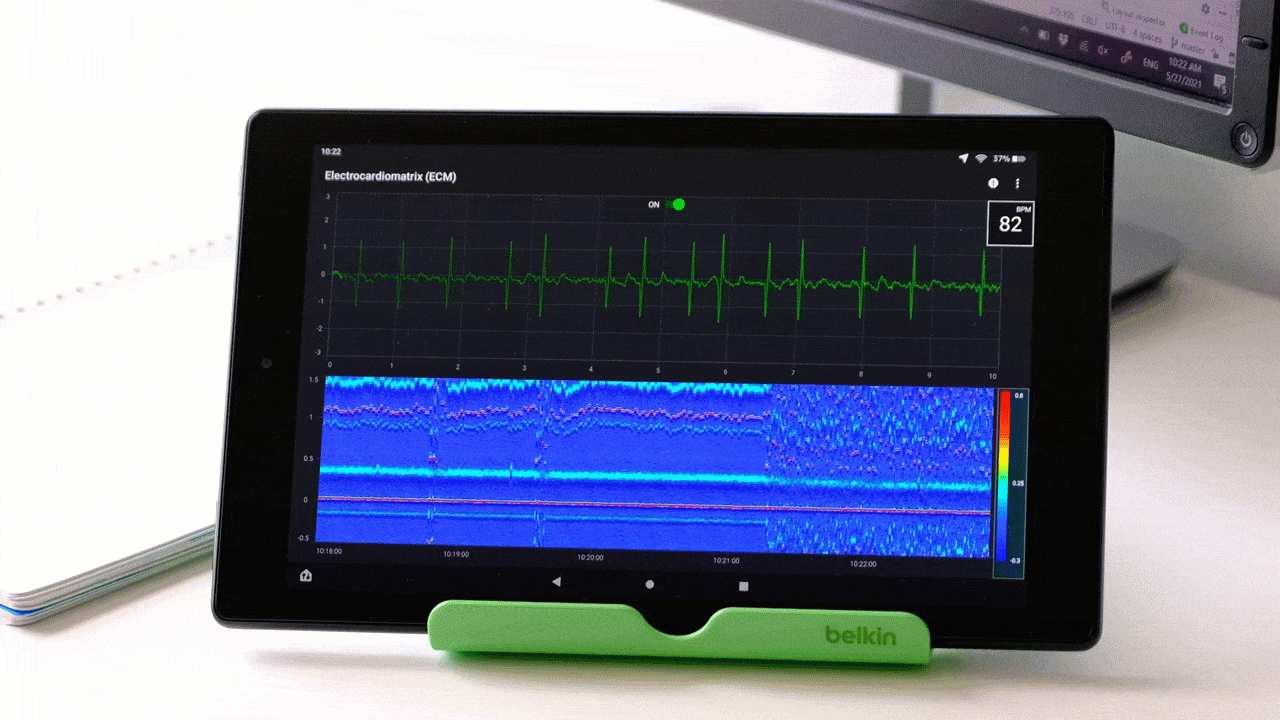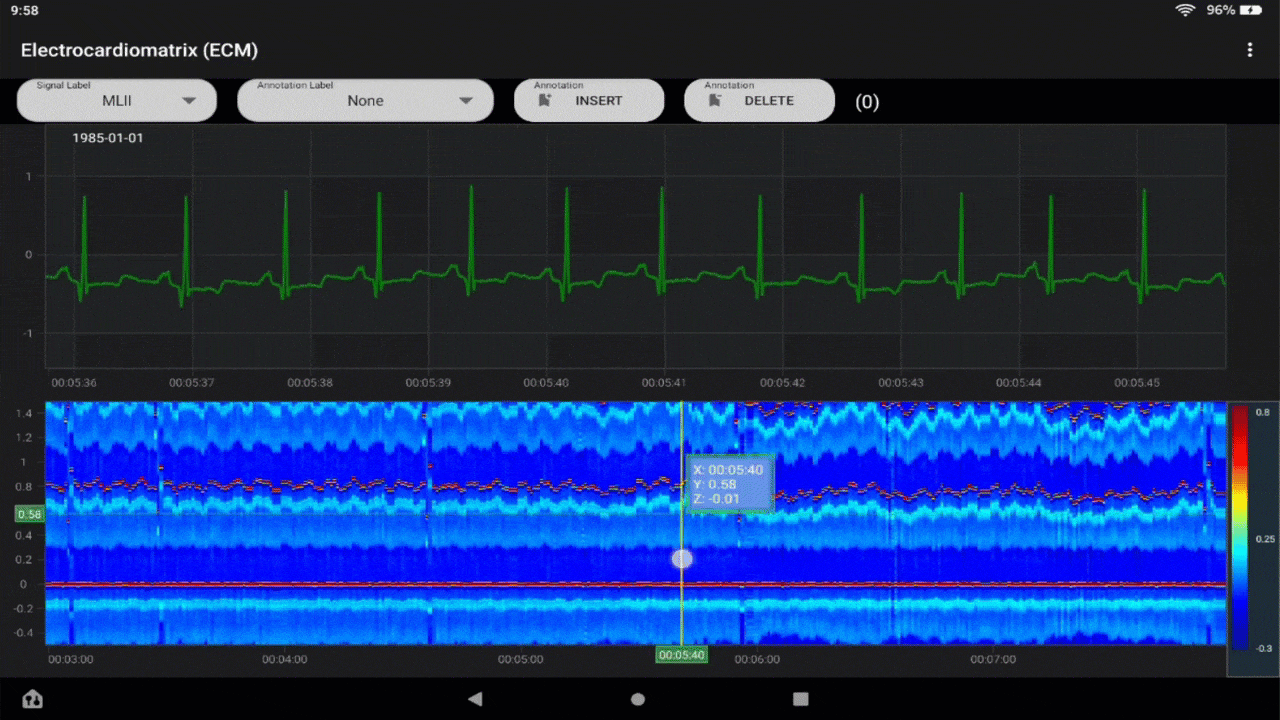
- Electrocardiomatrix (ECM) is an intuitive way to review long-term ECG signals.
- The project developed at BorjiginLab, at the University of Michigan aims to promote early and accurate Atrial Fibrillation Detection.
- Android App was created to allow patients themselves identify atrial fibrillation and send the suspicious recordings to cardiologist.
Promoting early screening of Cardiac Abnormalities with ECM technology
University of Michigan’s Jimo Borjigin, Ph.D. has developed a novel electrocardiomatrix (ECM) technology to permit efficient, intuitive, and accurate detection of cardiac abnormalities from electrocardiography (ECG) signals.
ECM is expected to promote early and accurate atrial fibrillation (AFIB) detection, permit stroke prevention, and reduce costs of diagnosis.
To promote early screening of AFIB in general population, our laboratory developed an Android App that communicates with a medical-grade wearable ECG device. The single-lead ECG signal is continuously streamed to the mobile phone or tablet and transformed into ECM instantaneously, which can be inspected visually in real-time.

This method permits accurate detection of paroxysmal AFIB with or without symptoms. With one glance of visual inspection, one can easily identify cardiac abnormalities, including AFIB, from long ECG/ECM recordings, with minimum training.
Patients can monitor their cardiac health at home during casual activities and send the report to their doctors for diagnosis.
Data Visualization Challenge
For live streaming ECM on the mobile devices, the biggest challenge is charting performance for the large amount of data points from the heatmap that consists of thousands of heartbeats.
Paroxysmal atrial fibrillation may occur suddenly and stop on its own during daily routine, it can be hard to be captured in just a few minutes. ECM provides users an efficient way to review thousands of heartbeats at a time. For example, a 30min-long ECM contains 3,600,000 data points for the ECG at 200Hz.
Data visualization of large amounts of data in real-time on mobile devices becomes crucial for app development and user experience.

Using SciChart Android Charting Library
SciChart is a high-performance charting solution on the market that is easy to implement to the mobile platforms.
This application uses the following features:
- FiFo charts series are used to display the top chart and visualize the ECG information in real-time.
- The heatmap chart type is to visualize the ECM data at the bottom of the application.
- The zooming and panning features of the SciChart allow users to navigate the details of the ECM in different scales.
- The annotation features presents healthcare providers a way to highlight a short ECG strip within a long-term ECM, and to annotate irregular heartbeats or cardiac rhythms with simple taps for further analysis.


Relevance
With the help of ECM, the cardiac rhythm changes and irregular heartbeats can be easily identified with visual inspection. The wearable hardware allows user monitoring continuous ECG for maximum 7 days with one coin battery.
Usually cardiologists review ECG signals in two ways. One is a few minutes of 12-lead ECG, which is ordered by the doctor when the patient feels something is wrong with their heart. However, some paroxysmal atrial fibrillation can be hard to be captured in a short period of time.
Another way is a Holter/event monitor, which records continuous long-term ECG for days. It is not possible for a cardiologist to check the raw ECG data beat by beat, which is time consuming and error-prune. Healthcare professionals only focus on the suspicious episodes that algorithm marked as arrhythmias, or the episodes with the marker when the patient pushed the button on the device. The false positives may overwhelm the cardiologists, while false negatives lead to misdiagnosis. That is where ECM comes in as it provides an affordable way that people can review long-term ECG with one glance. The accurate detection of atrial fibrillation outperformed the clinical team in our previous study (https://pubmed.ncbi.nlm.nih.gov/31177972/).
Patients with known or suspected heart conditions and health-conscious individuals are able to monitor their ECG 24/7 and interpret ECM with instructions. Patients can choose to share their recordings to the cardiologist or physician if they recognized cardiac abnormalities. The wearable device with chest belt or adhesive patch provides comfort and flexibility for daily routine.
The ECM definitely has other application scenarios like bedside ECG monitor, nursing station, ambulatory ECG monitoring, ECG monitoring during anesthesia, and more. Please visit http://ecmatrix.med.umich.edu for more information.
Further Reading
- The whole article and research paper can be found here: Electrocardiomatrix facilitates qualitative identification of diminished heart rate variability in critically ill patients shortly before cardiac arrest
- SciChart Android Example: Vital Signs ECG Example
- Other blog posts where SciChart for mobile is used in Digital Health domain: Data Visualization for the Epilepsy research Kit for Kids
Recent Blogs
